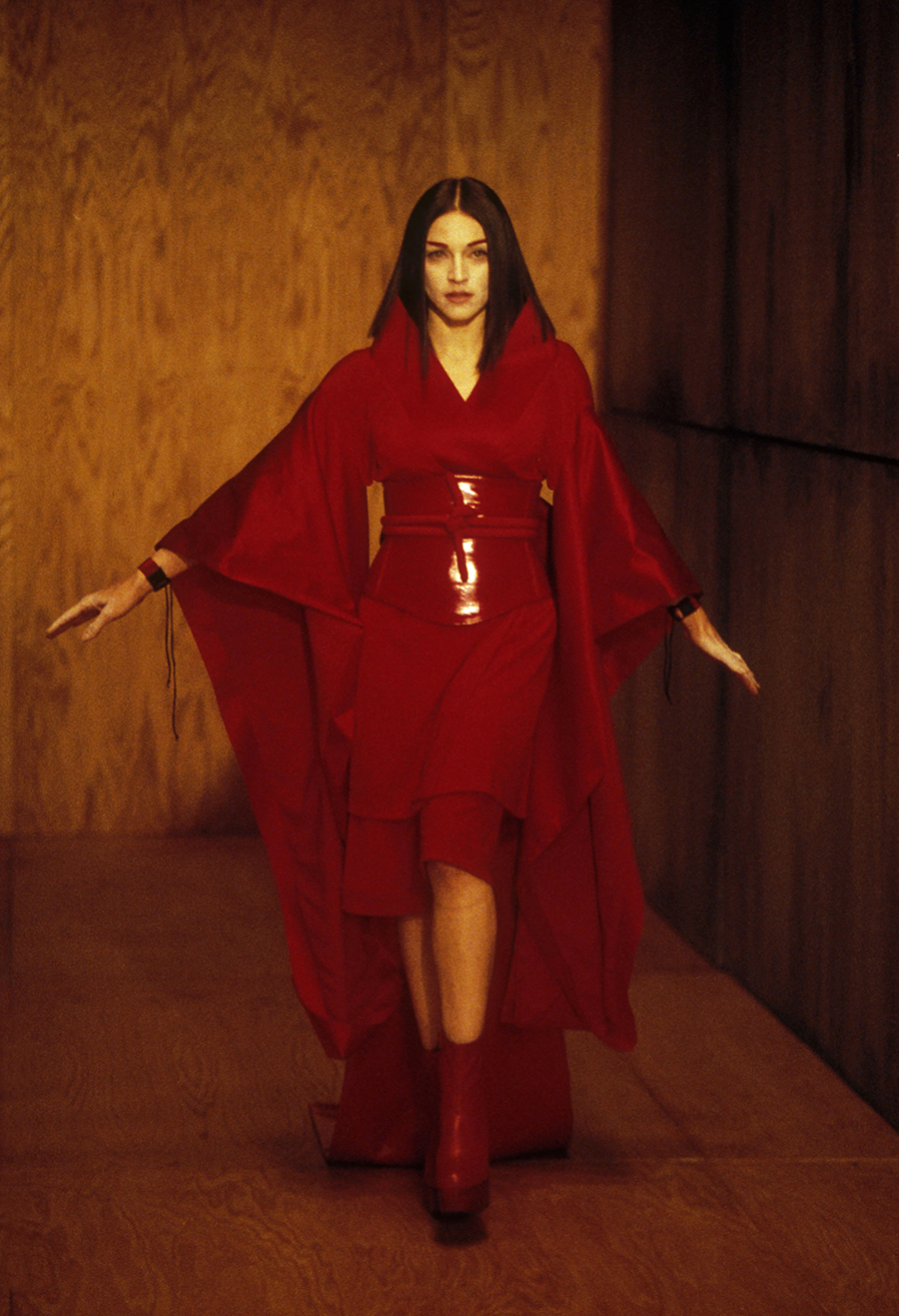V&A Kimono Review – Sartorial Abundance and Sketchy History
‘Kimono: Kyoto to Catwalk’ is a mesmerizing display of silk brocades and detailed craft, but glances over history’s muddier moments
‘Kimono: Kyoto to Catwalk’ is a mesmerizing display of silk brocades and detailed craft, but glances over history’s muddier moments

As a teenager, I spent many hours in London’s Victoria & Albert Museum, perched on a backless bench or even cross-legged on the floor, sketchbook in my lap, attempting to learn from the precious artefacts within its walls. I was especially drawn to the Japanese and Chinese galleries, whose objects represented the countries from which my mother’s family originated. At the time, I never imagined the museum might one day host Europe’s first major kimono exhibition, ‘Kimono: Kyoto to Catwalk’.

For sheer beauty, the garments do not disappoint. From the mid-to-late 19th century is a blue silk satin wedding kimono embroidered with sparrows in gold-wrapped silk. As the downlight refracts off the sheen of the creatures’ feathers, I think of warm sunlight catching the flit of living birds. It is easy to envy the wealthy young bride who would have been ensconced in this silken flock. Equally mesmerizing is the black bridal kimono, made half a century later, upon which appears a clutch of sharp-eyed, sharp-clawed hawks. Once seen as a fierce masculine symbol, these predatory birds became popular with young women during the Meiji era, when Japan was industrializing.

The emphasis of the exhibition is on fashion’s cross-pollination. One mid-18th-century kimono, featuring fingernail-small orange flowers set against a delicate pattern of white and blue, is crafted from French silk brocade. As the exhibition literature explains: the fine fabric, probably initially intended for a man’s suit, instead became a kimono for a wealthy Japanese woman. The garment’s red-orange bottom edge reflects a popular fashion in kimono and serves as a visual echo of the tiny French flowers. Nearby, a machine-spun kimono from the early 20th century bears a rose and lattice pattern reminiscent of the work of Scottish designer and architect Charles Rennie Mackintosh – who was himself influenced by Japanese culture.

Stretching across centuries and continents, the scope of the exhibition is vast and encompasses not just women’s kimono but hair ornaments, pattern books, woodblock prints and men’s kimono. These last range from a feudal lord’s simple blue check garment to a woodblock-print depiction of a wakashū: a young man wearing kimono in a feminine style to become a figure of erotic desire.

While the show excels in highlighting the beauty and craft of the kimono, the historical context is, at times, startlingly short. For instance, under a kimono decorated with warships appears the following text: ‘In the 1930s, when Japan invaded Manchuria and China, some men’s kimono designs became more nationalistic […] The imagery was confined to under-kimono and jacket linings, but this did not reflect a lack of patriotic fervour. In many ways, it meant an alignment with the nation’s goals on an intimate level.’ But what exactly were the goals this man was holding so close to his skin? There is no description of the hunger for international power and expansion or the atrocities in Asia that followed: biological weapons testing, the Nanjing Massacre, vivisection without anaesthesia. Nor does the plaque ask why Japan had become so focused on conquest. Consider only a few possible causes: having their borders forced open by gunboat diplomacy, fear of facing a similar fate to China during the Opium Wars, and the perceived need to imitate Europe in everything from bowler hats to empire-seeking. This era is complex, fraught and full of tragedy, but the exhibition texts glance upon it only briefly. To fully appreciate the twisting journey from ‘Kyoto to Catwalk,’ we must face the darkness as well as the beauty. But I understand that in an exhibition of this scale, and given the many thousands of visitors who will no doubt rush to and through it, pragmatic choices must be made: there is simply not enough space to give all the context.

Toward the end of the exhibit is a red ‘kimono ensemble’ designed for Madonna by Jean Paul Gaultier in 1998. The panel claims: ‘The combination of cropped kimono, matching shorts and PVC obi was more fashionable interpretation than costumed appropriation. Madonna was inspired by Arthur Golden’s bestselling book Memoirs of a Geisha (1997), referring to the novel’s antagonist Hatsumomo as her “muse.”’ Leaving aside the thorny issue of who gets to draw the faint line between ‘fashionable interpretation’ and cultural appropriation, this positive citation of Memoirs of a Geisha as inspiration without touching on the book’s controversy felt odd. In fact, the author’s primary source of information, former geisha Mineko Iwasaki, entirely rejected the book, claiming that it was full of inaccuracies, and sued Golden for defamation of character.

All this aside, I was grateful for the chance to see many sartorial masterworks. While I have seen enough exotifying yellowface in one lifetime to be wary of kimono as costume, it would be odd for my mixed-race self to argue for purity. I am curious to see the work of those who will be inspired by such an influx of beauty into this city. I have not worn a kimono in years, but a few seasons ago I bought a long, black, pleated skirt. The cut allows me to walk in purposeful strides. There are no cherry blossoms, no embroidery, no cranes, nothing that shouts Japan. But when I first showed it to my mother she said it looked to her like a kendo swordsman’s hakama. When I wrap my own cross-pollinated body in these folds, I feel briefly like a warrior.
‘Kimono: Kyoto to Catwalk’ is on view at the V&A, London, until 21 June 2020.
Main image: Fashionable brocade patterns of the Imperial Palace, woodblock print, made by Utagawa Kunisada, 1847-1852, Japan. Courtesy: Victoria and Albert Museum, London























